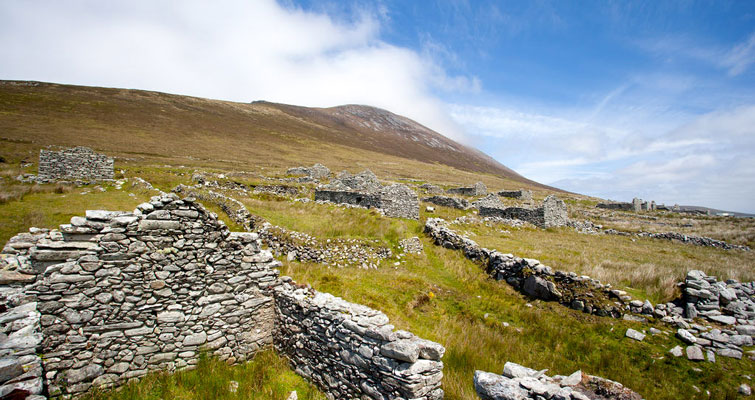The Deserted Village, Achill Island in Co. Mayo

Close by Dugort, at the base of Slievemore mountain (671 metres) lies the Deserted Village. The village is divided into three areas called Tuar, Tuar Riabach and Faiche. There are approximately 100 houses in the village, aligned north-south and parallel to each other.
The atmosphere of the Deserted Village is unique; it's remoteness; a feeling of almost intruding on those who lived there; a sense of the frugality of life in such a place and time and the overall air of mystery; who were they, why did they settle here, how did they survive and why did they leave?
The houses were built of unmortared stone, which means that no cement or mortar was used to hold the stones together. Each house consisted of just one room and this room was used as kitchen, living room, bedroom and even stable.
The doorways were east-facing, while one small window was built in the north-east wall. While one or two houses may have had a small stable built on to the end of the house, most families had to share their house with cows and other livestock, who would be brought into the house at night and tied at southern end. The tethering rings can still be seen in the walls.
The most of the houses had opposing doorways to facilitate families on their daily task of milking cows. The cow was taken in one door, milked, and then taken out through the opposing door.
Inside many houses, a shallow channel or drain in the floor led into a manure pit outside the building. This feature along with the opposing doorways suggests an earlier building phase.
According to archaeologists the field systems and the lazy beds found in this area indicate several occupation phases. Also some remains suggest there was a settlement here during the Anglo-Norman period.
The village was gradually abandoned because of the many evictions for non-payment of rent during Sr Richard O’Donnell’s tenure, the 1845-49 famines and the emigration throughout the successive years.
Until 1940s the village was used as a booley in summertime.
